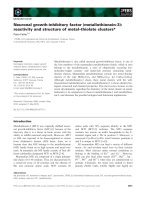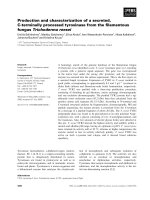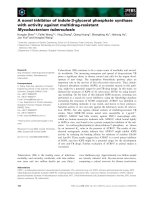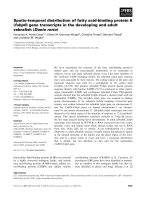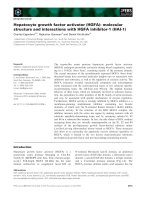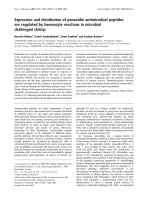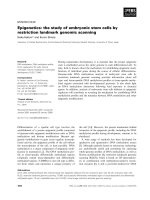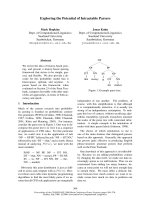báo cáo khoa học: "Autonomous growth potential of leukemia blast cells is associated with poor prognosis in human acute leukemias" ppt
Bạn đang xem bản rút gọn của tài liệu. Xem và tải ngay bản đầy đủ của tài liệu tại đây (304.7 KB, 10 trang )
BioMed Central
Page 1 of 10
(page number not for citation purposes)
Journal of Hematology & Oncology
Open Access
Research
Autonomous growth potential of leukemia blast cells is associated
with poor prognosis in human acute leukemias
Ying Yan*
1,2
, Eric A Wieman
1,2
, Xiuqin Guan
2
, Ann A Jakubowski
3
,
Peter G Steinherz
3
and Richard J O'Reilly
3
Address:
1
The Saint Luke's Cancer Institute, 4321 Washington, Suite 4000 Kansas City, Missouri 64111, USA,
2
School of Medicine, University
Missouri-Kansas City, Holmes Road Kansas City, Missouri 64108, USA and
3
Bone Marrow Transplantation Service and the Department of
Pediatrics, Memorial Sloan Kettering Cancer Center, New York, New York, USA
Email: Ying Yan* - ; Eric A Wieman - ; Xiuqin Guan - ;
Ann A Jakubowski - ; Peter G Steinherz - ; Richard J O'Reilly -
* Corresponding author
Abstract
We have described a severe combined immunodeficiency (SCID) mouse model that permits the
subcutaneous growth of primary human acute leukemia blast cells into a measurable subcutaneous
nodule which may be followed by the development of disseminated disease. Utilizing the SCID
mouse model, we examined the growth potential of leukemic blasts from 133 patients with acute
leukemia, (67 acute lymphoblastic leukemia (ALL) and 66 acute myeloid leukemia (AML)) in the
animals after subcutaneous inoculation without conditioning treatment. The blasts displayed three
distinct growth patterns: "aggressive", "indolent", or "no tumor growth". Out of 133 leukemias, 45
(33.8%) displayed an aggressive growth pattern, 14 (10.5%) displayed an indolent growth pattern
and 74 (55.6%) did not grow in SCID mice. The growth probability of leukemias from relapsed and/
or refractory disease was nearly 3 fold higher than that from patients with newly diagnosed disease.
Serial observations found that leukemic blasts from the same individual, which did not initiate
tumor growth at initial presentation and/or at early relapse, may engraft and grow in the later
stages of disease, suggesting that the ability of leukemia cells for engraftment and proliferation was
gradually acquired following the process of leukemia progression. Nine autonomous growing
leukemia cell lines were established in vitro. These displayed an aggressive proliferation pattern,
suggesting a possible correlation between the capacity of human leukemia cells for autonomous
proliferation in vitro and an aggressive growth potential in SCID mice. In addition, we
demonstrated that patients whose leukemic blasts displayed an aggressive growth and
dissemination pattern in SClD mice had a poor clinical outcome in patients with ALL as well as
AML. Patients whose leukemic blasts grew indolently or whose leukemia cells failed to induce
growth had a significantly longer DFS and more favorable clinical course.
Introduction
Acute leukemia originates from transformed normal
hematopoietic progenitor cells. The leukemogenic trans-
formation may require multiple steps at the molecular
and cellular level. During the leukemic transformation,
the stem cells could gradually acquire the potential for
spontaneous proliferation, and abnormal apoptosis.
The autonomous growth potential of the leukemia blasts
may result from autocrine stimulation and this may pre-
Published: 29 December 2009
Journal of Hematology & Oncology 2009, 2:51 doi:10.1186/1756-8722-2-51
Received: 29 September 2009
Accepted: 29 December 2009
This article is available from: />© 2009 Yan et al; licensee BioMed Central Ltd.
This is an Open Access article distributed under the terms of the Creative Commons Attribution License ( />),
which permits unrestricted use, distribution, and reproduction in any medium, provided the original work is properly cited.
Journal of Hematology & Oncology 2009, 2:51 />Page 2 of 10
(page number not for citation purposes)
dict the prognosis in some type of leukemias [1-5]. A
number of studies have shown that blasts from some
patients with acute leukemia displayed either a partially
or a totally autonomous growth pattern in liquid culture
medium or in clonogenic assays [6-8]. However, most of
the reports were based on studies of a short-term (3 or 7
days) culture of the leukemia blasts in serum-free medium
by a
3
H-thymidine incorporation assay or based on a 7
days colony forming assay in methylcellulose medium to
predict the leukemia blast proliferation activity [2,4,9,10].
Under these conditions, a substantial portion of blasts die
due to apoptotic pressure from the in vitro cell culture
soon after the culture starts. The possible contamination
by lymphocytes and monocytes may also interfere with
the determination of autonomous growth of the leukemic
blast cells. Thus, these methods may at best represent the
temporary in vitro growth ability of the blast cells, but
they may not accurately reflect the individual, intrinsic,
spontaneous proliferation and long-term proliferation
potential of leukemic blasts.
Recent studies have demonstrated that growth of some
human leukemia cells in the severe combined immuno-
deficiency (SCID) mouse model is analogous to their bio-
logical characteristics in patients. This method has
allowed human leukemic cells which in prior studies
failed to grow adaptively under in-vitro culture conditions
to propagate in SCID mice. The consistent ability of SCID
mice to propagate human leukemic cells thus provides a
new vehicle for studying the biologic characteristics and
proliferation potential of the various leukemia cells [11-
15].
We have developed a SCID mouse model that permits the
subcutaneous growth of primary human acute leukemia
blast cells and cells from the myeloid blast crisis of
chronic myelogenous leukemia [16,17]. The subcutane-
ous engraftment and growth of human leukemias in this
model are associated with dissemination of leukemia
blasts and reflect a pattern of growth similar to the usual
clinical presentation. Furthermore, human acute leuke-
mias in SCID mice displayed three distinct growth pat-
terns: aggressive, indolent or no growth [16]. In this report
we demonstrate that the proliferation ability of human
leukemias in a SCID mouse model is associated with
prognosis in acute human leukemias.
Materials and methods
Ptients
Patients with newly diagnosed or relapsed acute leuke-
mias at Memorial Sloan-Kettering Cancer Center
(MSKCC) were included in this study. One hundred thirty
three patients were studied after providing informed con-
sent. Their diseases were classified according to the
French-American-British (FAB) classification, based on
the morphology of cells as examined by light microscopy.
The clinical and hematologic characteristics of the
patients are summarized in Table 1. The mean age of the
patients was 20 years (range, 3 to 76). Eighty six patients
were male and 47 were female with a M/F ratio of 1.83/1.
Out of 67 acute lymphoblastic leukemias (ALLs),
27(40%) were newly diagnosed, 38(57%) had recurrent
disease, and 2 patients (3%) with T-ALL had primary
refractory leukemia. In the patients with B-lineage-ALLs,
22/53 pre-B-ALLs were newly diagnosed and 6 of them
demonstrated high risk features (WBC >50,000/μl and/or
age >10 years); 31 pre-B-ALLs and 3 B-cell lymphoma/
leukemias (B-ALL L3) had relapsed disease. In T-ALLs, 5/
11 patients were newly diagnosed and 3 of them demon-
strated high risk features; 6/11 T-ALLs had relapsed and/
or refractory disease. The mean age of patients with ALL
was 12 years (range, 1 to 54) and the M/F ratio was 1.79/
1. Out of 66 patients with acute myeloid leukemia (AML),
35(53%) were newly diagnosed, including 2 patients
(AML M2 and M4) who had a history of myelodysplasia
(MDS) and 3 patients (AML M1, M4 and M5) diagnosed
as secondary leukemia after treatment for osteogenic sar-
coma, desmoplastic small round cell tumor, and neurob-
lastoma, respectively; 29(44%) patients had relapsed
disease and 2(3%) had primary refractory leukemia. The
mean age of the patients with AML was 27 years (range, 1
to 75) and the M/F ratio was 2/1.
All patients received induction chemotherapy and were
assessed for signs of a complete remission (CR) after one
or two courses of therapy. Patients achieving CR were
treated with at least two cycles of consolidation chemo-
therapy (AML) and risk group adjusted maintenance
chemotherapy (ALL). Fifteen patients with ALL under-
went bone marrow transplantation (BMT) (13 allogeneic
and 2 autologous), and 26 patients with AML received
BMT (23 allogeneic and 3 autologous). A complete remis-
sion was defined by a marrow with less than 5% blasts,
normal hematopoiesis with normal peripheral blood
counts, and disappearance of extramedullary leukemic
cell infiltration.
Table 1: Characteristics of 133 patients with acute leukemias
Characteristic Patients No. (%)
Immunophenotype and FAB Category of ALL 67 (50.4)
B-linage-ALL 56 (42.1)
Pre-B-ALL (L1 and L2) 53 (39.8)
Lymphoma/leukemia B-ALL (L3) 3 (2.3)
T-ALL (L1 and L2) 11 (8.3)
FAB Category of AML 66 (49.6)
M1 myeloblastic without maturation 19 (14.3)
M2 myeloblastic with maturation 13 (9.8)
M3 promyelocytic 13 (9.8)
M4 myelomonocytic 11 (8.3)
M5 monoblastic, monocytic 5 (3.8)
M7 megakaryoblastic 3 (2.3)
Unclassified 2 (1.5)
Journal of Hematology & Oncology 2009, 2:51 />Page 3 of 10
(page number not for citation purposes)
Immunophenotype of the blasts was determined by flow
cytometry [16]. Standard cytogenetic techniques, includ-
ing cell preparations, cultures and banding techniques
were used for examining the karyotype of patient-derived
leukemic blasts as well as for the cells recovered from
leukemic nodules grown in SCID mice.
Inoculation of human leukemic cells into SCID mice
Samples were obtained, with informed consent, during
routine diagnostic blood studies or bone marrow (BM)
aspirates from patients with newly diagnosed or relapsed
acute leukemia. Blast-enriched mononuclear cells were
isolated by Ficoll Hypaque density gradient separation
and washed in RPMI 1640 medium. After separation,
most of the leukemic cells were freshly inoculated into
SCID mice. In some patients leukemic cells were cryopre-
served in liquid nitrogen prior to their injection into the
animals. SCID (CB17-scid/scid) mice were purchased
from Taconic Farms and maintained in microisolater
cages in the animal laboratory under sterile conditions
with a specific pathogen-free environment without the
use of any antibiotics. Female SCID mice between 6-8
weeks of age were used. The method of inoculation of
leukemia cells into SCID mice has been described [16].
Viability of the cells was determined by trypan blue stain-
ing. 1-2 × 10
7
viable leukemic cells were injected subcuta-
neously into the right flank of the SCID mouse. The
number of SCID mice inoculated and the cell dose per
mouse were dependent on the number of leukemic cells
available from patient samples. Leukemic cell growth was
assessed by weekly measurements of dimensions of the
subcutaneous nodules.
For secondary passage of leukemia cells, the cells were
harvested from tumor tissue removed from SCID mice
and inoculated into fresh animals with a similar cell dose
and method used as for the first passage. To determine the
dissemination of human leukemia cells into distal organs
of the animals, tissue sections from sacrificed SCID mice
were prepared and stained according to standard tech-
niques for histopathology assay. Fluorescence in Situ
Hybridization(FISH) was performed as previously
described [16].
Long-term in vitro culture of leukemic cells
Blast-enriched mononuclear cells isolated by Ficoll
Hypaque from patient-derived samples or mononuclear
cells recovered from leukemic nodules were washed and
plated into α-MEM medium containing 10% Fetal calf
serum, penicillin (100 U/ml), streptomycin (100 μg/ml)
and L-glutamine 2 mmol/L (Sigma) at a density of 5 × 10
5
cells/ml in 37°C, 10% CO
2
and fed one or twice a week.
Statistical analyses
For statistical analysis, overall (OS) survival of patient was
determined from the time of initial diagnosis until death
from any cause or to last follow-up. Disease-free survival
(DFS) was measured from the time of the first complete
remission after induction therapy until the time of the
first relapse after complete remission, or to the date of last
follow-up, if none of the preceding events had occurred.
Curves of OS and DFS of the patients with the various
leukemia growth patterns in SCID mice were constructed
using the method of Kaplan and Meier, statistical signifi-
cance was determined with the Log-rank test and Wil-
coxon test.
Results
Engraftment and growth of human acute leukemias in
SCID mice
Leukemic blasts derived from each of the 133 leukemia
patients were subcutaneously inoculated into SCID mice.
In several patients, specimens had been serially collected
at different times during the course of their disease, and
inoculated into the animals both at diagnosis and at
relapse. However, the calculation of engraftment and
growth rate was based on the initially obtained sample.
Out of 133 patients, leukemia blast samples from 59
(44.4%) engrafted and adoptively grew in SCID mice. In
relation to clinical status, the probabilities of engraftment
and growth of human acute leukemias in SCID mice were
14/62 (22.6%) for the newly diagnosed leukemias and
45/71 (63.4%) for the relapsed and/or refractory disease
cases, respectively.
The engraftment and growth pattern of leukemic blasts
from ALL and AML were listed in Table 2. Thirty of 67
(44.8%) patients derived ALL cells were able to grow in
SCID mice. The growth rates were similar in B-lineage-ALL
(25/56; 44.6%) and T-ALL (5/11; 45.5%). Five (18.5%)
samples from 27 newly diagnosed ALL were able to grow
in the SCID mice. In contrast, 25 (62.5%) samples from
40 relapsed or refractory ALL patients were able to induce
subcutaneous tumor growth. Similarly, 9 out of 35
(25.7%) samples derived from newly diagnosed AML
patients were able to grow in SCID mice. In contrast, 20/
31(64.5%) relapsed AML samples were able to induce
subcutaneous tumor growth and dissemination.
In general, a similar anatomic-pathologic picture was
observed in most of the mice with leukemic engraftment.
SCID mice bearing fast growing human leukemia tumors
might develop axillary lymph node enlargement, hepat-
osplenomegaly, mediastinal lymphadenopathy or
mesenteric lymphadenopathy. Histopathologic, FISH,
and FACS analysis showed marked infiltration by human
leukemic cells in bone marrow, peripheral blood, spleen,
liver and other organs. In contrast, in animals with no
leukemia engraftment, there was no appreciable splenic
or liver enlargement or other clinical signs that would
indicate leukemia development, and there was no evi-
Journal of Hematology & Oncology 2009, 2:51 />Page 4 of 10
(page number not for citation purposes)
dence of leukemic cell infiltration detectable by FISH,
FACS or histopathological analysis of the tissues.
In vitro growth potential of the leukemia cells
We cultured cells from 102 patient-derived samples as
well as 45 samples recovered from leukemic nodules in
vitro without cytokine supplementation. Nine leukemic
cell lines developed from different patients were autono-
mously grew up and established in vitro. The characteris-
tics of the patients whose leukemia blasts developed into
cell lines are listed in Table 3. These 9 patients died soon
after collection and inoculation of the specimens from
which the cell lines were established. Eight cell lines were
derived from relapsed patients. One was from a patient
with secondary AML that arose after treatment for desmo-
plastic small cell tumor. The blasts, which were the source
of these cell lines, displayed an aggressive growth pattern
in all 9 cases (Figure 1), suggesting a possible correlation
between autonomous in vitro proliferation and an aggres-
sive growth pattern in vivo.
Growth potential of leukemia blasts derived from the same
patient is different during different clinical stages
To investigate whether or not the growth potential of
leukemia blasts at different clinical stages of the disease is
different, leukemia specimens were serially collected from
the same patient at initial presentation and at relapse.
Leukemia blasts derived from a newly diagnosed AML
patient (MA11 M4) were not able to engraft and grow in
SCID mice, however, the cells collected at the time of the
first and second relapse (rel-1 and rel-2) engrafted and
grew in mice in an indolent manner. The cells from rel-1
grew very slowly. Tumor size did not achieve 1 cm
2
until
80 weeks after inoculation. In contrast, the tumor size was
2.2 cm
2
by week 78 after inoculation with cells from rel-2
(Figure 2a.). In the case of a pre-B-ALL (BA35) patient,
with leukemia cells from rel-1 were not able to engraft and
grow. The cells collected during rel-2 and rel-3 displayed
an indolent and aggressive growth pattern, respectively.
The tumor originated from relapse 2 reached a surface
area of 0.8 cm
2
at week 80 after inoculation. And cells
from relapse 3 grew into a tumor with a surface area of 3.1
cm
2
at 18 weeks after relapse-3 (Figure 2b.). The patient
died at 3 months after her third relapse. A similar observa-
tion was seen in a patient with T-ALL (TA7) (Figure 2c.),
with no growth at initial presentation. Cells at relapse
demonstrated an aggressive growth pattern. This tumor
achieved a surface area of 3.5 cm
2
within 15 weeks. Sur-
vival of this T-ALL patient was less than 6 months after his
relapse.
In vivo propagation potential of human leukemic cells in
SCID mice was studied in cells originally derived from
TA7 and a pre-B-ALL (BA17) (Figure 2c and 2d.). Cells
harvested from subcutaneous tumor nodule were inocu-
lated subcutaneously into secondary SCID mice with the
same cell number used in the original passage. The growth
of each subsequent passage of the leukemia cells was sig-
nificantly more rapid than during the first passage. The
TA7 leukemic cells grew to a tumor size 8 cm
2
in 7 weeks
during secondary passage while they were not measurable
at this time during the primary passage. In patient BA17,
leukemia blasts derived from rel-1 induced an indolent
growth pattern and only achieved a tumor size of 2 cm
2
by
80 weeks. However, the cells in the second and third pas-
sages displayed an aggressive growth by 23 weeks, the
tumor sizes were 5 and 8 cm
2
, respectively.
Relationship between growth patterns of leukemic cells
and clinical stages
In a previous study [16], we found that there were 3 dis-
tinguishable growth patterns for human acute leukemias
in SCID mice: aggressive growth, indolent growth and no
growth. Similar growth and dissemination patterns of the
leukemias were demonstrated in the current study. Out of
133 leukemias, 45 (33.8%) present an aggressive growth
pattern, 14 (10.5%) had an indolent growth pattern and
74 (55.6%) did not grow in SCID mice. The mean time for
the tumors to reach 1.0 cm
2
and 2.0 cm
2
surface area was
11.4 ± 3.5 and 15.2 ± 5.2 weeks in those with an aggres-
sive growth pattern (Table 4). In contrast, the mean time
for the tumors to reach 1.0 cm
2
and 2.0 cm
2
were 35.9 ±
13.1 and 43.9 ± 14.1 weeks, respectively, for those with an
indolent growth pattern.
The tumor growth patterns for the different types of leuke-
mia are listed in Table 4. Eighteen out of 56 (32%) B-lin-
eage-ALLs displayed an aggressive growth pattern and 7/
56 (13%) had an indolent growth pattern. These corre-
lated with the clinical status; 15/18 (83%) B-lineage-ALLs
that grew aggressively and 4/7(57%) that had an indolent
pattern, were derived from patients with relapsed and/or
refractory disease, respectively. All the samples from 5 T-
ALLs (4 relapsed and 1 refractory disease) that engrafted
Table 2: Probability of engraftment and growth of human ALL
and AML blasts in SCID mice by subcutaneous inoculation
Leukemias No. Engraftment & Growth (%) p-value
ALL 67 30 (44.8%)
B-lineage-ALL 56 25 (44.6%)
new 22 5 (22.7%)
rel/ref 34 20 (58.8%) p < 0.05
T-ALL 11 5 (45.5%)
new 5 0 (0%)
rel/ref 6 5 (83.3%) p < 0.01
AML 66 29 (43.9%)
new 35 9 (25.7%)
rel/ref 31 20 (64.5%) p < 0.01
new = newly diagnosis; rel/ref = relapse/refractory
Journal of Hematology & Oncology 2009, 2:51 />Page 5 of 10
(page number not for citation purposes)
in SCID mice, displayed an aggressive growth pattern. 17
of 22 (77%) AML leukemia samples with an aggressive
growth pattern were derived from patients with relapsed/
refractory disease.
No growth and indolent growth patterns in SCID mice
suggest a more favorable clinical outcome for ALL and
AML patients
We followed 66 ALL patients. They are separated into
three groups according to the growth patterns of their
leukemic cells in SCID mice. 23 patients' leukemic blasts
(18 B-lineage-ALL and 5 T-ALL) presented an aggressive
growth pattern; 7 patients with pre-B-ALL displayed an
indolent growth and 36 (30 pre-B-ALL and 6 T-ALL) had
"no growth".
First remission duration of patients with ALL in these
three groups is demonstrated in Figure 3. Patients, whose
leukemic cells exhibited an aggressive growth pattern, had
a very poor clinical course no matter whether the cells
were obtained at diagnosis or at relapse. The median DFS
was 0.375 years (0-5.9 years) and median OS was 1.42
years (0.2-6.9 years). Twenty two Patients died of progres-
sive disease, with the exception of one pre-B-ALL patient,
who survived 6.9+ years in his third remission.
In contrast to the "aggressive group", a more favorable
clinical outcome was found in newly diagnosed patients
with "no growth" and "indolent" growth. The mean DFS
and OS was 5.3 years (p < 0.001) and 5.5 years (p <
0.001), respectively. Twenty out of 25 patients in this
group were relapse free and only 5 patients died of leuke-
mia progression. Patients with relapsed disease, who did
not have aggressive growth, had an intermediate outcome
with a 2.6 year (p = 0.004) and 4.3 year (p = 0.002) mean
DFS and OS, respectively. However, 11/18 patients died
of leukemia progression. Seven patients maintained their
remission (6 in CR2 and 1 in CR3).
Of the 66 AML patients studied, one (M2) had incomplete
clinical data available and the result of the 13 acute pro-
myelocytic leukemias (APL) will be reported separately
below. The 52 remaining patients were separated into 3
groups according to the growth pattern of their leukemic
cells as above. Twenty relapsed (n = 13) or newly diag-
nosed (n = 7), had an aggressive growth pattern. These
patients had a poor clinical outcome, with a median DFS
of 0.32 (0-8.3) years (Figure 4.). Only one patient is still
in CR, 8.3 years after an allogeneic BMT. The other 19
patients relapsed within a year. Eighteen patients had died
of leukemia progression. The OS in these patients was
0.68 (0.2-9.8) years.
A more favorable clinical outcome was found in the
patients with "no growth" or "indolent" growth. Twenty-
two of these patients were studied at diagnosis. Eight had
maintained at CR1 and 14 (63.6%) died of leukemia pro-
gression. The median DFS was 1.0 (0.1-10.5) years, signif-
icantly longer than that of the aggressive growth group (p
= 0.018). The median OS was 1.2 (0.1-10.7) years, longer
than that of the aggressive growth group, although the dif-
ference was statistically insignificant (p = 0.36). Only 7
newly diagnosed patients had an aggressive growth pat-
tern. Six (85.7%) patients died within one year except one
is still alive, with no evidence of disease 8 years after
achieving remission. Their median DFS and OS were 0.23
(0.05 - 8.3) and 0.46 (0.1-8.6) years, respectively, shorter
than that of the "no growth" or "indolent" growth group.
However, there were too few cases, which had an aggres-
sive pattern at diagnosis, to archive a statistical signifi-
cance. Therefore, a future study including a larger number
of patients would be necessary to further confirm a poor
prognosis in the patients who had an aggressive growth
pattern at diagnosis.
Thirteen APLs had been included in this study, from
whom 5 patients derived leukemia sample were able to
engraft and grow in SCID mice. Out of 6 newly diagnosed
APLs, 1 patient whose leukemia cells grew in the animals,
displayed an indolent growth pattern. In 7 APLs with
relapse disease, leukemia blasts from 4 patients displayed
either aggressive growth (n = 2) or indolent growth pat-
tern (n = 2), respectively. The mean times of their leuke-
mic tumor size arrived to 1.0 cm
2
and 2.0 cm
2
surface
areas were 15.9 ± 3.6 and 21.4 ± 5.8 weeks for the 2
patients with aggressive pattern, and 33.2 ± 8.8 and 41.7
± 14.4 weeks for the 3 APL with indolent growth pattern,
respectively. The probability of engraft and growth of APL
leukemia 5/13 (38%) seems compatible with the general
Aggressive growth pattern of 9 acute leukemia cell lines in SCID miceFigure 1
Aggressive growth pattern of 9 acute leukemia cell
lines in SCID mice.
0
1
2
3
4
5
6
7
8
BA25
BA78
BA91
BA127
TA7
TA27
TA83
MA120
MA126
0 4 8 1216 202428323640
Weeks post-inoculation
Surface Area (cm
2
)
Journal of Hematology & Oncology 2009, 2:51 />Page 6 of 10
(page number not for citation purposes)
AML group (Table 2); however, the clinical outcome was
obviously more favorable for the APL patients. The
median DFS and OVS were 4.4 and 8.6 years, respectively,
for the entire group of the APL patients.
Discussion
A number of factors have been shown to have prognostic
values in human acute leukemias. For example: the bio-
logical characteristics of the leukemic cells such as mor-
phology phenotype, specific karyotypic abnormalities
and response to therapy have prognostic values in the
leukemias. Studies have demonstrated that the in vitro
autonomous proliferation potential of patient derived
leukemia blasts can influence ALL as well as AML progno-
sis [1-4]. Lowenberg et al. reported an in vitro study which
measured the uptake of tritiated thymidine by leukemic
cells in serum-free and cytokine-free cultures as a means of
determining the rate of spontaneous proliferation in 114
newly diagnosed AML patients. In that study, leukemia
blasts displayed either a low, intermediate, or high prolif-
eration pattern, and patients with high rates of prolifera-
tion activity had a poor prognosis [1]. The capacity for
autonomous proliferation of leukemia blasts is associated
with the degree of aggressiveness of acute leukemia [1,4].
In the present study, we examined the ability of patient-
derived acute leukemia cells to grow and disseminate in
SCID mice by subcutaneous inoculation without condi-
tioning treatment or administration of growth promoting
cytokines. Leukemic cells from 59 of 133 (44.4%) patients
were successfully engrafted into mice. In our SCID mouse
model, patient-derived leukemia blasts also displayed
three distinct growth patterns: either aggressive, indolent
or no growth. We correlated the growth patterns of blasts
to the status of patients during follow up studies. We
observed that the aggressive growth pattern of leukemic
cells derived from ALL as well as AML patients is corre-
lated with a poorer clinical outcome. No growth and
indolent growth are correlated with a more favorable out-
come. Our observation is in agreement with the previous
studies.
In our study, 26% of samples from newly diagnosed AML
could engraftment and growth in the animals. In recent
publications, Sanchez et al demonstrated a higher engraft-
ment rate (37% with ≥ 10% leukemia cells infiltrating
marrow, plus 14% ≥ 1% infiltrating leukemia cells) after
intravenous injection of samples from patients presenting
with AML into a IL2R NOD/SCID mice model [15]. The
IL2R NOD/SCID mice, which have been depleting T, B as
well as NK cells function. This results a higher immune
competent potential. They also treated the animals with
sublethal irradiation (250 cGy of total body irradiation)
24 hours before IV injection of leukemic cells. All these
factors may influence and increase the AML sample
engraftment and growth rate in the animals. In contract,
we used CB17-scid/scid mice (homozygous for the severe
combined immune deficiency characterized by an
absence of functional T and B cells, but maintaining func-
tional NK cells) without any conditioning treatment
before inoculation. This might lead to a lower engraft-
ment and growth rate. Therefore, introduction of the IL2R
NOD/SCID mice as well as the immunosuppressive con-
ditioning treatment before inoculation may improve
leukemia growth rate in this subcutaneous SCID mouse
model in future studies.
In correlation to clinical status, the probability of engraft-
ment and growth of leukemia blasts collected during
relapse reaches 63%, which is nearly 3 times higher than
the growth potential of blasts collected upon initial diag-
nosis (23%). The ability of patient-derived blasts to
Table 3: Characteristics of the leukemia cell lines established in long-term in vitro cultures
Leukemia cell lines Classifications Clinical Status Survival*
(months)
Kayotypes
BA25** B-ALL (L3) Relapse-1/refractory 1.3 45, xy, t(2;8)(p12;q24),-4,+7,-10, idemx2; 44-47, t(2:8)(p23, q24)
BA78** B-ALL (L3) Relapse-1/refractory 0.4 45-47, XY, t(8;14)(q24, q32),-16 +1
BA91 B-ALL (L3) relapse-1 4.5 45-46, XY, t(8;14)(q24, q32),
-9, t(11;18)(q13;p11), +14, -16,
+mar1, +mar2, +mar3
BA127 Pre-B-ALL (L1) relapse-2 0.8 nd
TA7** T-ALL (L1) relapse-1 6.0 46, XY
TA27 T-ALL (L1) relapse-1/refractory 3.0 46, XY
TA83 T-ALL (L1) relapse-2/refractory 1.5 46, XY, del(9)(p21), -7,
t(11;14)(p13;q11.2) -7
MA120** AML (M2) relapse-2/refractory 2.5 46, XY, del (16)(q13q22),
dup(1) (q44q25)
MA126 AML (M4) secondary leukemia 1.1 46, XY, t(9;11)(p21, q23)
*Survival of patients after leukemia specimens had be taken; nd: not done.
** Cell lines established from leukemic nodules in SCID mice. The primary specimen did not grow.
Journal of Hematology & Oncology 2009, 2:51 />Page 7 of 10
(page number not for citation purposes)
engraft and grow in SCID mice was also enhanced as the
same patient progressed in his clinical stages. We also
observed the engraftment and growth potential of leuke-
mia cells is enhanced accompanying each subsequent
relapse (Figure 2). This observation is in agreement with
our previous study on chronic myelogenous leukemia
(CML) in the same SCID mice system. The leukemia cells
from chronic and accelerated phase had very little or no
permanent engraftment and growth potential, however,
cells from blast crisis grew and disseminated [17]. All
these facts suggested that the ability of leukemia blasts
engraftment and proliferation was gradually acquired
along the progression of leukemia in most patients.
ALL patients whose leukemic cells had a low growth
potential enjoyed a better OS and DFS as compared to
patients whose cells had high growth potential in each
group. This observation suggested that patients whose
leukemia cells maintained lower proliferation characteris-
tics responded to treatment better.
Engraftment and growth patterns of leukemia blasts derived from individual patients with different clinical status in SCID miceFigure 2
Engraftment and growth patterns of leukemia blasts derived from individual patients with different clinical sta-
tus in SCID mice. a. Leukemia blasts obtained from MA11 at initial diagnosis did not engraft and growth in SCID mice. The
cells collected from her first relapse (rel-1) and second relapse (rel-2) was grown in the mice in an indolent manner, respec-
tively. The patient died of leukemia 2 months later after the injection of rel-2 cells. b. BA35 was a patient with pre-B-ALL.
Leukemia sample from initial diagnosis was not studied. The blasts of rel-1 were not able to engraft and grow. Cells from rel-2
and rel-3/ref displayed an indolent and aggressive growth pattern, respectively. The patient died of leukemia 3 months after
refractory disease development. c. TA7 was from a newly diagnosed patient with T-ALL. Leukemia cells from initial diagnosis
did not grow. Cells from first relapse had an aggressive growth pattern. Leukemic cells recovered from subcutaneous tumor,
were able to initiate a more rapid proliferation than the cells in first passage. d. BA17 was a pre-B-ALL who relapsed after a 40
months complete remission and died of leukemia progression 3 months after relapse. His leukemia cells from rel-1 displayed an
indolent growth. However, the adoptive growth in second and third passages displayed an aggressive growth pattern.
0
1
2
3
4
BA35 rel-1
BA35 rel-2
BA35 rel-3
0
1
2
3
4
MA11 new
MA11 rel-1
MA11 rel-2
0
2
4
6
8
10
12
TA7 new
TA7 rel-1
TA7 p2
0
2
4
6
8
10
12
BA17 rel-1 p-1
BA17 p-2
BA17 p-3
a
b
c
d
Weeks post-inoculation
0
10 20
40
30
50
60 70 80
0
10 20
40
30
50
60 70 80
Surface area (cm
2
)
Journal of Hematology & Oncology 2009, 2:51 />Page 8 of 10
(page number not for citation purposes)
Similar to those with ALL, patients with newly diagnosed
AML whose leukemia cells had no growth or indolent
growth pattern had a better DFS than the patients with an
aggressive pattern, suggesting that an aggressive growth
pattern can serve as an index for worse prognosis of
human AML as well. However, we found that relapsed
AML patients whose cells had indolent growth did not
demonstrate a significantly better OS than the relapsed
patients with an aggressive growth pattern. This might
suggest that factors other than the aggressive growth pat-
tern of human leukemic cells might be of prognostic
value.
We established 9 in vitro leukemia cell lines out of 147
leukemia specimens. The in vitro cell lines may represent
leukemia cells with maximal autonomous growth poten-
tial. All the patients from whom the cell lines derived were
in their later stages of the disease when the samples were
obtained. All the leukemia cell lines displayed an aggres-
sive growth pattern in SCID mice, suggesting that the in
vitro growth potential of the leukemia blasts is correlated
and consistent with their in vivo growth potential.
In this study, leukemia cells from 38.5% APL patients
were able to induce engraftment and growth in SCID
mice, with no significant difference to other AMLs in SCID
mice. However, the clinical outcome was obviously favo-
rable for the APLs, in comparison with other leukemias,
suggesting an effect therapeutic strategy could be impor-
tant to the leukemia patients, even with an aggressive dis-
ease. Improved therapy for APL, which changes the
prognosis of APL from a fatal leukemia to a highly curable
disease, is one of the major achievements of leukemia
research, reflecting the accomplishment from the combi-
nation of progress in both laboratory science and well-
designed clinical trials [18-23]. Due to the limited
number of APLs in this study, it would be necessary to
study more patients to clarify and confirm if and why the
Table 4: Mean Time of Leukemic Tumor Achieved 1.0 cm
2
and
2.0 cm
2
of Surface Areas
Leukemia category
and growth patterns
1.0 cm
2
(weeks) 2.0 cm
2
(weeks)
Leukemia (overall)
Aggressive n = 45 11.4 ± 3.5 (n = 45) 15.2 ± 5.2 (n = 39)
Indolent n = 14 35.9 ± 13.1 (n = 14) 43.9 ± 14.1 (n = 12)
AMLs
Aggressive n = 22 12.1 ± 4.2 (n = 22) 17.4 ± 6.7 (n = 19)
Indolent n = 7 31.1 ± 6.2 (n = 7) 40.1 ± 7.8 (n = 6)
B-linage-ALLs
Aggressive n = 18 11.9 ± 4.3 (n = 18) 14.8 ± 5.4 (n = 16)
Indolent n = 7 43.1 ± 16.1 (n = 7) 50.3 ± 15.7 (n = 6)
T-ALLs
Aggressive n = 5 9.5 ± 2.9 (n = 5) 11.3 ± 2.9 (n = 5)
Probability of first remission duration of ALL patients in relation to the growth pattern of their leukemic blasts in SCID miceFigure 3
Probability of first remission duration of ALL patients in relation to the growth pattern of their leukemic
blasts in SCID mice. Patients whose leukemic cells grew aggressively (newly diagnosed or relapsed, n = 23) had a poor clin-
ical outcome. Patients whose leukemic blasts displayed either no tumor growth or an indolent growth pattern at newly diagno-
sis (n = 25) had a favorable clinical outcome. Patients whose leukemic blasts displayed no tumor growth or an indolent pattern
at relapse (n = 18) also had a relatively favorable clinical outcome.
0123456789101112
Years of DFS
0
20
40
60
80
100
No growth or indolent at diagnosis (25 Pats. 20 censored)
No growth or indolent at relapse (18 Pats. 0 censored)
Aggressive growth at diagnosis/relapse (23 Pats. 0 censored)
Probability of first remission duration
Journal of Hematology & Oncology 2009, 2:51 />Page 9 of 10
(page number not for citation purposes)
APL blasts grow in SCID mice despite a favorable clinical
outcome. In addition, considering the heterogeneity of
the AML patient samples in this study, a larger number of
patients with the specific AML subtypes need to be studied
to determine any correlations between the clinical out-
come and the incidence of the different patterns of leuke-
mic growth in SCID mice.
In conclusion, the in vivo growth characteristics of the
leukemic blasts can be considered as an important prog-
nostic factor in ALL and in AML. The ability of leukemia
blasts to engraft and proliferate is gradually acquired fol-
lowing leukemia progression in most patients. The growth
characteristics of the leukemic blasts should be considered
in the assignment of patients to different therapeutic
options. In addition, a prospective study can be included
in the future to evaluate the molecular mechanism that
contributes to the different growth characteristics of the
leukemic blasts.
Competing interests
The authors declare that they have no competing interests.
Authors' contributions
YY carried out the animal experiments and participated in
the design of the study and research coordination. EW car-
ried out research data and statistics analysis and drafted
the manuscript. XG participated in animal experiments.
AJ participated in patient specimens and clinical data col-
lection. PS carried out clinical research, coordinated
patient specimen and clinical data collection and drafted
the manuscript. RO conceived of the design of the study
and coordination. All authors read and approved the final
manuscript.
Acknowledgements
This work was supported by grants from the National Institutes of Health
(CA23766), the Lisa Biloti Foundation and the Saint Luke's Research Foun-
dation.
References
1. Lowenberg Bob, van Putten Wim, Ivo P: Touw, Ruud Delwel, and
Valeria Santini: Autonomous proliferation of leukemic cells
in vitro as a determinant of prognosis in adult acute myeloid
leukemia. N Engl J Med 1993, 328:614-619.
2. Hunter AE, Rogers SY, Roberts IA, Barrett AJ, Russell N: Autono-
mous growth of blast cells is associated with reduced survival
in acute myeloblastic leukemia. Blood 1993, 82(3):899-903.
3. Doepfner KT, Spertini O, Arcaro A: Autocrine insulin-like
growth factor-I signaling promotes growth and survival of
human acute myeloid leukemia cells via the phosphoi-
nositide 3-kinase/Akt pathway. Leukemia 2007, 21(9):1921-30.
4. Kukita T, Arima N, Matsushita K, Arimura K, Ohtsubo H, Sakaki Y,
Fujiwara H, Ozaki A, Matsumoto T, Tei C: Autocrine and/or para-
crine growth of adult T-cell leukaemia tumour cells by inter-
leukin 15. Br J Haematol 2002, 119(2):467-74.
Probability of first remission duration of AML patients in relation to the growth patterns of their leukemic blasts in SCID miceFigure 4
Probability of first remission duration of AML patients in relation to the growth patterns of their leukemic
blasts in SCID mice. Patients (newly diagnosed or relapsed, n = 20) whose leukemic cells grew aggressively had a poor clin-
ical outcome. In contrast, patients whose leukemic blasts displayed either no tumor growth or an indolent growth at initial
presentation (n = 22) had a favorable clinical outcome. Patients whose leukemic blasts displayed no tumor growth or an indo-
lent pattern at relapse (n = 10) also had a poor out come.
Publish with BioMed Central and every
scientist can read your work free of charge
"BioMed Central will be the most significant development for
disseminating the results of biomedical research in our lifetime."
Sir Paul Nurse, Cancer Research UK
Your research papers will be:
available free of charge to the entire biomedical community
peer reviewed and published immediately upon acceptance
cited in PubMed and archived on PubMed Central
yours — you keep the copyright
Submit your manuscript here:
/>BioMedcentral
Journal of Hematology & Oncology 2009, 2:51 />Page 10 of 10
(page number not for citation purposes)
5. Ayala F, Dewar R, Kieran M, Kalluri R: Contribution of bone
microenvironment to leukemogenesis and leukemia pro-
gression . Leukemia 2009, 23(12):2233-2241.
6. del Canizo MC, Brufau A, Almeida J, Galende J, Garcia Marcos MA,
Mota A, Garcia R, Fernandez Calvo J, Ramos F, Fisac P, Orfao A, San
Miguel JF: In vitro growth in acute myeloblastic leukaemia:
relationship with other clinico-biological characteristics of
the disease. Br J Haematol 1998, 103(1):137-42.
7. Harris RJ, Pettitt AR, Schmutz C, Sherrington PD, Zuzel M, Cawley
JC, Griffiths SD: Granuloctye-macrophage colony-stimulating
factor as an autocrine survival factor for mature normal and
malignant B lymphocytes. J Immunol 2000, 164(7):3887-93.
8. te Boekhorst PA, Lowenberg B, van Kapel J, Nooter K, Sonneveld P:
Multidrug resistant cells with high proliferative capacity
determine response to therapy in acute myeloid leukemia.
Leukemia 1995, 9(6):1025-31.
9. Smith MA, Luxton RW, Pallister CJ, Smith JG: 7. A novel predictive
model of outcome in de novo AML based on S-phase activity
and proliferative response of blast cells to haemopoietic
growth factors. Leuk Res 2002, 26(4):345-8.
10. Sutherland H, Blair A, Vercauteren S, Zapf R: Detection and clini-
cal significance of human acute myeloid leukaemia progeni-
tors capable of long-term proliferation in vitro. Br J Haematol
2001, 114:296-306.
11. Lapidot T, Sirard C, Vormoor J, Murdoch B, Hoang T, Cacerres-
Cortes J, Minden M, Paterson B, Callgiuri M, Dick J: A cell initiating
human acute myeloid leukaemia after transplantation into
SCID mice. Nature 1994, 367:645.
12. Bonnet D: Humanized model to study leukemic stem cells.
Methods Mol Biol 2009, 538:247-62.
13. Chelstrom LM, Gunther R, Simon J, Raimondi SC, Krance R, Crist
WM, Uckun FM: Childhood acute myeloid leukemia in mice
with severe combined immunodeficiency. Blood 1994, 84:20.
14. Pearce DJ, Taussig D, Zibara K, Smith LL, Ridler CM, Preudhomme C,
Young BD, Rohatiner AZ, Lister TA, Bonnet D: AML engraftment
in the NOD/SCID assay reflects the outcome of AML: impli-
cations for our understanding of the heterogeneity of AML.
Blood 2006,
107:1166-1173.
15. Sanchez PV, Perry RL, Sarry JE, Perl AE, Murphy K, Swider CR, Bagg
A, Choi JK, Biegel JA, Danet-Desnoyers G, Carroll M: A robust
xenotransplantation model for acute myeloid leukemia.
Leukemia 2009, 23(11):2109-17.
16. Yan Y, Salomon O, McGuirk JP, Dennig D, Fernandez J, Jagiello C,
Nguyen HN, Collins N, Steinherz P, O'Reilly RJ: Growth pattern
and clinical correlation of subcutaneously inoculated human
primary acute leukemias in severe combined immunodefi-
ciency mice. Blood 1996, 88:3137-314.
17. McGuirk J, Yan Y, Childs B, Fernandez J, Barnett L, Jagiello C, Collins
N, O'Reilly RJ: Differential growth patterns in SCID mice of
patient-derived chronic myelogenous leukemias. Bone Marrow
Transplant 1998, 22(4):367-74.
18. Lowenberg B, Griffin JD, Tallman MS: Acute myeloid leukemia
and acute promyelocytic leukemia. Hematology 2003:82-101.
19. Kelaidi C, Chevret S, De Botton S, Raffoux E, Guerci A, Thomas X,
Pigneux A, Lamy T, Rigal-Huguet F, Meyer-Monard S, Chevallier P,
Maloisel F, Deconinck E, Ferrant A, Fegueux N, Ifrah N, Sanz M, Dom-
bret H, Fenaux P, Adès L: Improved outcome of acute promye-
locytic leukemia with high WBC counts over the last 15
years: the European APL Group experience. J Clin Oncol 2009,
27(16):2668-76.
20. Shen ZX: Molecular target therapy - towards curative regi-
men: a 20-year experience in the treatment of acute promy-
elocytic leukemia (APL) in the Shanghai Institute of
Hematology. J Hematol Oncol. 2009, 2(Suppl 1):A1.
21. Wang ZY, Chen Z: Acute promyelocytic leukemia: from highly
fatal to highly curable. Blood 2008, 111(5):2505-15.
22. Gregory TK, Wald D, Chen Y, Vermaat JM, Xiong Y, Tse W: Molec-
ular prognostic markers for adult acute myeloid leukemia
with normal cytogenetics. J Hematol Oncol. 2009, 2:23.
23. Nowak D, Stewart D, Koeffler HP: Differentiation therapy of
leukemia: 3 decades of development. Blood 2009,
113(16):3655-65.
